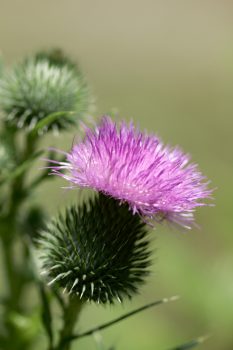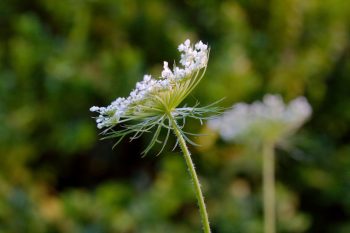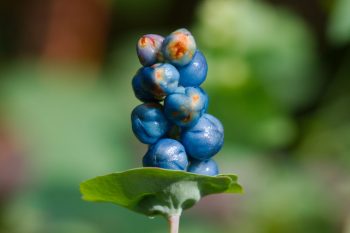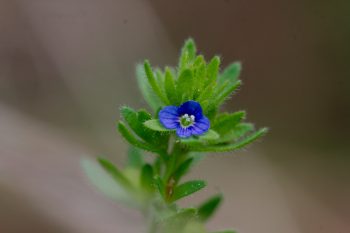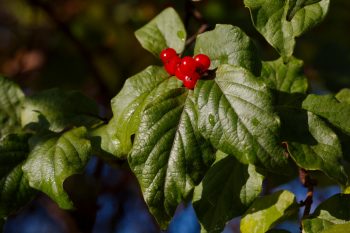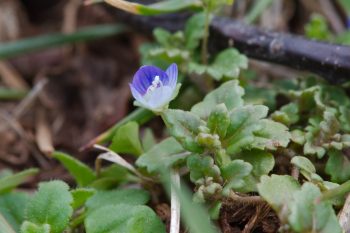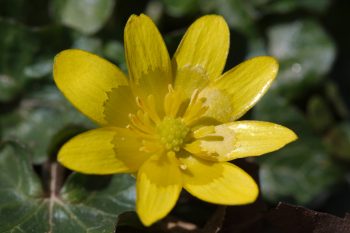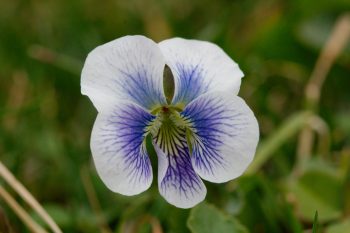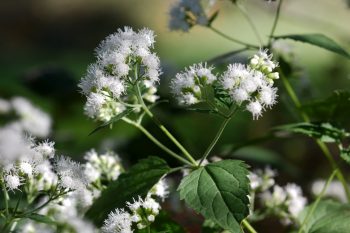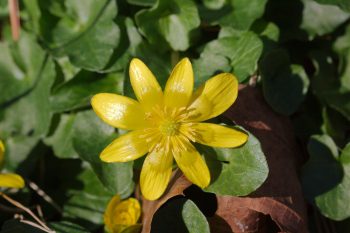Anyone good at identifying thistles? There are hundreds of them and many of them look much like this. Anyway, as much as I don’t like thistles in the garden, they sure have pretty flowers.
Tagged With: Weed
Queen Anne’s Lace
My grandmother carried a bouquet of Queen Anne’s lace (Daucus carota var. carota) at her wedding. For their 50th anniversary party we gathered bucket loads of the stuff from empty fields and had it all round the room. You are probably familiar with the flowers, as it’s a pretty common plant all across the United States and bordering provinces of Canada as well as Europe and Asia. This is the wild carrot from which our cultivated carrot descended. It is reported to have been first developed in Afghanistan. It is a biennial plant, blooming in their second year.
Mile-a-Minute Vine (Polygonum perfoliatum)
Mile-a-minute vine, also known as devil’s tail and tearthumb, is an herbaceous annual vine in the buckwheat family. If you’ve ever encountered it you will know where the name tearthumb comes from. It is native to Asia but has become naturalized throughout the area and is a serious pest. Think of bindeed on steroids and with seriously barbed stems but without interesting flowers. It does have interesting fruit, I have to admit. These little berries are less that 5mm across but they are such a clear, beautiful blue, I cannot help but enjoy them. That’s not to say I would ever consider growing this for the ornamental value of the berries, of course. But they are still pretty.
Veronica arvensis (Corn Speedwell)
It was a beautiful day and I took the opportunity to go out and take a few pictures in the empty lot next to my office. Although we had a lot of rain this winter and early in the spring, April has been relatively drier than usual (at least that’s how if feels, I haven’t checked the actual data). Nevertheless, the drainage pond that is usually dry in the summer was about has high as it can be without the entire upper area being a bog. In a slightly higher part of the area I found quite a bit of this little corn speedwell (Veronica arvensis) growing. It’s a native to Europe and has been introduced widely in North America (according to the US Department of Agriculture, it can be found in every state except North Dakota, and I wouldn’t be surprised if it’s actually there, too. The blooms are quite small, only about a quarter inch across, and are a lovely blue color. As weeds go, there are worse.
Lonicera maackii (Amur Honeysuckle)
This is one of the more prevalent weed shrubs in our area. The Amur honeysuckle (Lonicera maackii) is an east Asian native that has firmly established itself as noxious weed in the eastern half of North America. It’s got the sweet, tubular flowers typical to honeysuckles, starting out white and aging to yellow. They are followed in the fall (right about now, obviously) by bright red, juicy berries. Although they are inedible to humans, birds eat them and spread the seeds far and wide. They were once planted as an ornamental and you can see why. However, they are no longer recommended, because of their invasive nature.
Veronica persica (Persian Speedwell)
I went outside today in the early afternoon and walked to the empty lot next to my building. It still looks mostly brown but there are little bits of color if you look hard enough. The seedling pears are just about to start blooming and there is a small amount of pink in their otherwise white buds. The hairy bittercress (Cardamine hirsuta) is starting to bloom everywhere. Those flowers are white and not terribly conspicuous. Even less conspicuous because they are so small are the beautiful, tiny blue flowers of Persian speedwell (Veronica persica, also known as bird’s-Eye speedwell). You really have to look for them, but once you start to see them, you’ll notice them everywhere.
Ficaria verna
This is Ficaria verna, formerly known as Ranunculus ficaria, commonly called the fig buttercup or lesser celandine. It is a weed and is listed as a noxious weed by a bunch of states and banned in at least two. It’s growing wild in the area around the pond next to my building. I’ve had enough experience with invasive weeds that I understand the desire to keep them out so I wouldn’t ever plant this. Nevertheless, I can appreciate the beautiful, bright yellow flowers. It is a tuberous rooted, herbaceous perennial native to western and central Asia and Europe. After flowering, the leaves die back by early summer and the plant goes dormant until the next spring.
Wild Violet
The wild violets (Viola sororia) are up in the lawn. They’re pretty difficult to get rid of but our lawn is not particularly weed free in general, so they are among the least of our worries. The flowers range in color from nearly all white to nearly all bluish purple. This one is about half way in between. We actually have a few yellow violets and I’m assuming those are a different species, possibly Viola pubescens, but I don’t actually know that. They look very similar to these, except for the flower color.
Ageratina altissima (White Snakeroot)
This is a weed and we pull it up but it’s actually fairly attractive. It’s called white snakeroot (Ageratina altissima) and it’s a fairly common native plant in our area. It’s similar to the blue mistflower (Conoclinium coelestinum) that we have in some of our borders but quite a bit taller (it’s three or four feet tall, compared to about about a foot and a half). This one is behind some shrubs so managed to get pretty much full grown before I noticed it. It will be gone shortly but I thought I’d take some pictures, anyway.
Ficaria verna
Dorothy, Cathy, and I walked on the Seneca Greenway Trail this afternoon, parking where MD 28 crosses Seneca Creek and walking downstream. We only saw a few other people and it was a very pleasant walk. It’s relatively flat, with only a few ups and downs to deal with. The birds were out in force and we heard them all around, although we weren’t stopping to see them so much and didn’t really get very close to any. I did stop to take a few photos, including of this fig buttercup, also known as lesser celandine. It was formerly classified as Ranunculus ficaria but is now Ficaria verna. It’s an invasive, non-native species that grows in many of our wetlands.

